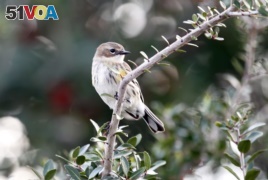In 1896, many birds were killed so women of high social standing in the United States could wear hats made with their feathers.
Two women, Minna Hall and Harriet Hemenway of Boston, Massachusetts, asked their friends to help stop the practice. They chose to name their group, the Massachusetts Audubon Society, after John James Audubon, a naturalist famous for his paintings of American birds.
Now, 125 years after its founding, the organization along with nearly 500 Audubon Society chapters faces a problem with another side of Audubon’s life: He owned enslaved people and opposed freeing them.
Changes in the environmental movement
In the year since George Floyd was killed by Minneapolis police, Audubon chapters have promised to do more to correct the wrongs of the past. The groups are employing people from different racial groups and finding ways to make natural spaces more welcoming to people of color.
It is part of a broader change within the wider environmental movement. There has been criticism of the movement for years because of its racist beginnings and lack of diversity.

FILE – A warbler is seen sitting on a branch during a bird count on the Gulf Coast in Grand Isle, Louisiana.
Last autumn, Mass Audubon published a document recognizing how Audubon’s family wealth came in large part from running a Caribbean sugar farm. It has also promised to have people of color make up 25 percent of its leadership committee and hopes to open more wildlife refuges in communities of color. The National Audubon Society, which is based in New York, has similarly looked into its history in a series of writings.
And the Sierra Club publicly apologized last July for the racist views of its founder, John Muir. Muir had called American Indians “dirty savages.”
The group has also promised to spend $5 million to increase its environmental justice work. Recently, the Sierra Club said it supports repayments to Blacks for the damage caused by slavery.
Debbie Njai founded the outdoor group BlackPeopleWhoHike. “At this point, if people are not part of what they’re trying to protect, that’s an issue,” she said.
David O’Neill is president of Mass Audubon. He agreed, “If we don’t get younger and we don’t get more diverse, we’re not going to have people to advocate on behalf of nature, and that’s not good for anyone.”
Green 2.0 is a Washington, DC-based group that puts out a yearly report on diversity in the environment. It reports that the nation’s largest environmental groups added, on average, six people of color to their workforce, and only three to their leadership between 2017 and 2020.
Andres Jimenez is head of Green 2.0. He said green organizations appear to be making progress on improving staff diversity, but their leadership remains mostly white. More change is needed at the top of the organizations, he added.
Changing bird names
Another movement for change — Bird Names for Birds — is to stop using names of birds that honor slaveholders and white supremacists.
That effort started last summer after an argument between a Black birdwatcher and a white woman with her dog in New York’s Central Park. The video of the event was widely seen, producing #BlackBirdersWeek and other similar efforts to show that Black nature enthusiasts face discrimination and other dangers in the outdoors.
Christian Cooper, the birdwatcher, is also a leading member of the New York City Audubon Society. He said his chapter has been trying to draw more diverse members through small events like last month’s Juneteenth birdwatching and picnic.
“The organizations that are having the most success are those that are trying new things,” Cooper said. He added that fixing hundreds of years of unfair treatment is “hard and uncomfortable work.”
Back at Mass Audubon, O’Neill says the organization has added new members so that 17 percent of them are people of color. Its workforce of more than 950 is now about 65 percent white.
I’m Jill Robbins.
Philip Marcelo wrote this story for the Associated Press. Jill Robbins adapted it for Learning English. Hai Do was the editor.
_____________________________________________________________________
Words in This Story
feather – n. any one of the light growths that make up the outer covering of the body of a bird
chapter – n. the people in a certain area who make up one section of a large organization
diversity – n. the state of having people who are different races or who have different cultures in a group or organization
savage – n. old-fashioned + offensive. a person who has a way of life that is simple and not highly advanced
advocate – v. to support or argue for (a cause, policy, or such.)
picnic – n. a meal that is eaten outdoors especially during a trip away from home
What do you think of the recent social justice actions by environmental organizations? We want to hear from you. Write to us in the Comments Section.